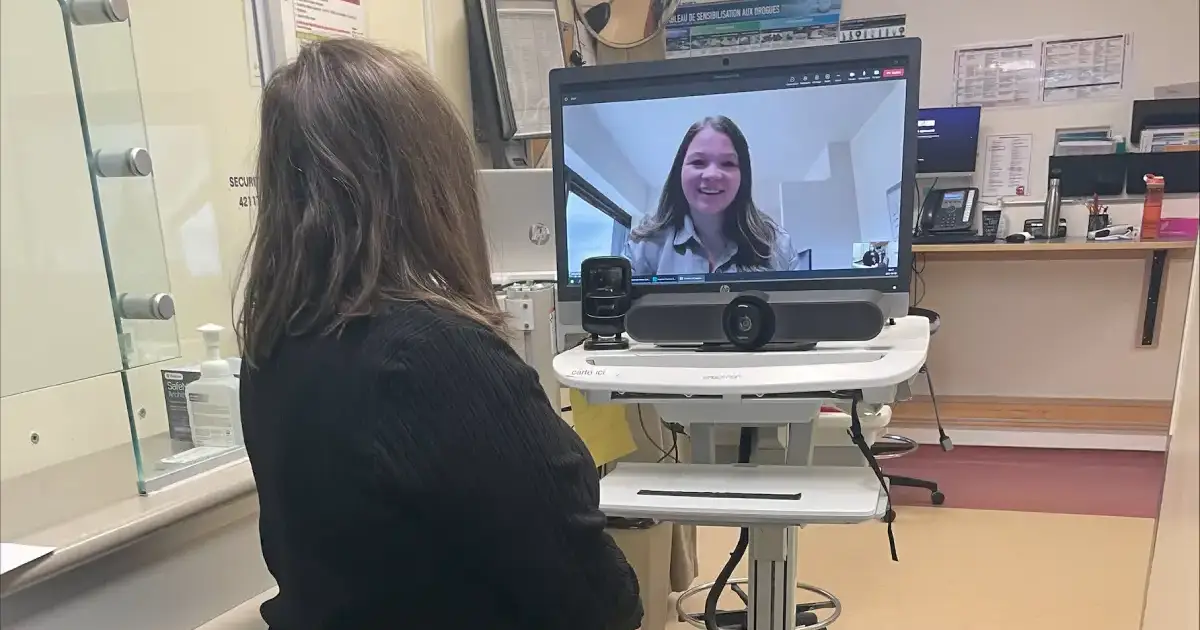The idea of using a telehealth modality for pre-triage in the emergency department was born at CHU de Québec-Université Laval in the spring of 2022. Originally, the establishment was looking for ways to continue to benefit from the expertise of nurses absent from the “floor” for safety reasons (pregnancy, injury, immunosuppression, etc.). As a result, nurses trained to work remotely in a secure room were able to support their emergency room colleagues. At the same time, the addition of a virtual nurse lightened the workload of on-site nurses.
How does it work in practice?
On arrival at the emergency department, the patient is quickly directed to a telehealth station equipped with a computer, screen, camera and code reader for the health insurance card. The nurse and patient can see each other on the screen, and communicate verbally via this audio-visual device. The remote nurse controls the camera movements and the computer in front of the patient.
The remote nurse is also involved in the reassessment of waiting patients. These reassessments need to be carried out periodically to ensure that patients do not deteriorate while waiting. With access to the waiting room surveillance cameras, the remote nurse can call patients back to the telehealth station.
Benefits for patients and staff
According to emergency department guidelines, when the waiting time is more than 10 minutes between a patient’s arrival and the start of a full triage assessment, the nurse must carry out a brief assessment (pre-triage). In a context of manpower shortages, this target can sometimes prove difficult to meet. The telehealth modality makes it much easier, as the assigned nurse is surplus to the on-site team.
The experience at CHU de Québec-Université Laval has led to other significant gains for patients:
- Waiting time between pre-triage and triage now rarely exceeds one hour, whereas in the past we could observe delays of up to 3 or 4 hours.
- The reassessment rate has risen significantly, from 22% to 55%. The reassessment rate is the percentage of patients who undergo at least one reassessment during their waiting period.
Two nurses testify to the benefits of this practice:
When an extra virtual nurse is present, we see a big difference. Workload and stress are reduced. We can then concentrate on our other tasks, such as ambulance triage and patient reassessments.
As a surplus nurse, I’m able to respond much more quickly to patients who come to the pre-triage. What’s more, with the equipment at my disposal, I can quickly communicate with the team on site if a situation requires it.
Elsewhere in the healthcare network
Since the experience at CHU de Québec-Université Laval, other establishments have tried the experiment with success. These include some of the emergency rooms at CIUSSS de la Capitale-Nationale and CIUSSS du Saguenay-Lac-St-Jean.
This practice can now continue to expand in Quebec emergency rooms. The Ministère de la Santé et des Services sociaux has just published guidelines on the use of telehealth for brief emergency room assessments. These guidelines provide a framework for the use of simple, accessible technologies for the benefit of patients, care teams and facilities wishing to make better use of their resources in a context of manpower shortages.
Telehealth continues to move forward
The Quebec healthcare network is increasingly deploying initiatives that make use of information and communications technologies. These technologies, known as “telehealth”, are always used to complement conventional services. Care teams use telehealth to promote access to services and ensure equitable quality of care for all.
Several projects and initiatives have already been the subject of articles right here on telesantequebec.ca. These include teledermatology, virtual mental health care, addiction medicine in remote areas, youth health and telethrombolysis for stroke treatment.
